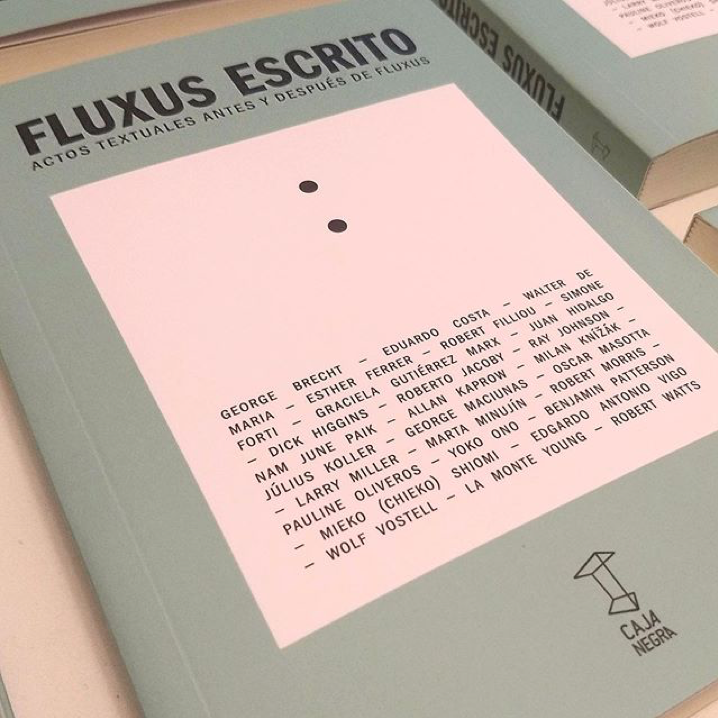Forms of formless knowledge
MARIANO MAYER. ON “FLUXUS WRITTEN. TEXTS ACTS BEFORE AND AFtER FLUXUS”
by
Around the early 1960s, art as a series of objects gave way to the idea of art as activity. Many art pieces made at that time aimed to lead human capacities towards constructing techniques of sociability. The modern world was a source of many beautiful images and a number of artists found a path that expanded the categories of aesthetics. Ever since 1962, when George Maciunas first coined the word “Fluxus” for an “international magazine of art and anti-art, music and anti-music, poetry and anti-poetry”, Fluxus became the name for an iconoclastic exercise against the set of artistic conventions. Unlike other types of group, Fluxus began before it had a name, and was not a closed list of members. A global zone for encounters between experimental artists, it was a porous phenomenon that aimed to reconquer the metaphorical power of everyday happenings. All of its acts take us to the world. For Fluxus, the movements of people in a supermarket could be conceived as a sound composition; the description of how a germinating onion balances on a bottle could be presented as a dance piece; or the act of cleaning your teeth each morning in front of the mirror might prompt a question on the transformational power of art. Fluxus draws our attention towards things that are not artistically motivated but can be rediscovered as unsuspected manifestations of art.
In the intersections between different disciplines, Fluxus found an ephemeral, playful means of working, absent of solemnity. At a time like the present, where interdisciplinarity has become structurally embedded, it seems essential to take a look back at the “intermedial” nature of Fluxus, whose rupture with western art history continues into the present. The movement’s interest in making works “in between” different media has a bearing on the alternating disciplines and forms of knowledge in contemporary art practices. The book Fluxus escrito. Actos textuales antes y después de Fluxus (Fluxus Written. Text Acts Before and After Fluxus) (Caja Negra, 2019), offers elements for a revision of one of the determining moments in art of the latter half of the twentieth century which might help us understand how to act collectively in the present.
REGISTRATION: To take part in each reading session and receive the selected bibliography, please contact bulegoa@bulegoa.org
PARTICIPATION:in-person and online
NUMBER: maximum of 15 people (in-person participation)
Mariano Mayer (Buenos Aires, Argentina, 1971) is a poet and independent curator who has been living in Madrid since 2002. His most recent curatorial projects include Distancias elásticas: Antonio Menchen y Cecilia Szalkowicz, Centro Párraga (Murcia, 2019); En el ejercicio de las cosas, with Sonia Becce (Plataforma Argentina ARCOmadrid 2017); La música es mi casa: Gastón Pérsico (MALBA, Buenos Aires, 2017); Isla de Ediciones (arteBA, Buenos Aires, 2017/2016); Soy un libro que no he escrito ni he leído Capítulo II (The Goma, Madrid, 2015); Soy un libro que no he escrito ni he leído Capítulo I, (Mite, Buenos Aires 2014); Fisicismos, with Manuela Moscoso (Universidad Torcuato Di Tella, Buenos Aires, 2013); June Crespo: Reverso (Have a Window, Torino, 2013); Visible, Móvil, Vidente (Centro Párraga, Murcia, 2012–2013); XXIII Circuitos de Artes Plásticas (Sala de Arte Joven Comunidad de Madrid; 2012) and Plano, peso, punto y medida (Universidad Torcuato Di Tella, Buenos Aires, 2011). Publications include Fluxus Escrito (Caja Negra, Buenos Aires, 2019); Justus (Diputación de León and Instituto Leonés de Cultura, 2009); Fanta (Corregidor, Buenos Aires, 2002). In 2016 he was Curating Professor of the Artist Programme, Universidad Torcuato Di Tella, Buenos Aires and directed the discursive programme on Argentinian art “Una novela que comienza” (CA2M, Móstoles, 2017). He is currently working on the following exhibitions: Azucena Vieites (Sala Alcalá 31, Madrid) and Diego Bianchi (CA2M, Móstoles).
